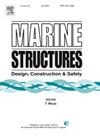Study of bearing capacity and failure envelopes of SEPLA under combined loading
IF 5.1
2区 工程技术
Q1 ENGINEERING, CIVIL
引用次数: 0
Abstract
The suction embedded plate anchor (SEPLA) has gained prominence as an effective anchoring solution for offshore floating platforms, owing to its precise installation capabilities and superior load-bearing efficiency. Most existing literature primarily focuses on SEPLA's uniaxial bearing capacities under vertical (V), horizontal (H), or moment (M) loading. However, during the keying process or under extreme environmental conditions, SEPLA is often subjected to complex combinations of vertical, horizontal, and moment (VHM) loads, which is the primary motivation for this study. Using the coupled Euler-Lagrange (CEL) method, this study conducts a comprehensive large deformation finite element analysis of SEPLA under various combinations of vertical, horizontal, and moment loads, both pairwise and simultaneously. The study aims to determine the failure envelopes for load-bearing capacity under different loading combinations. A parametric analysis of these failure envelopes under various combined loading planes is performed. The results show that the anchor embedment depth, even after normalization, significantly influences the shape of the failure envelope, while the effects of anchor shape and interfacial friction are largely eliminated through normalization. A closed-form equation is developed to approximate the three-dimensional failure surface that dictates SEPLA’s bearing capacities under combined VHM loading. The findings of this research contribute to expanding the database for plate anchor bearing capacity under combined loading and provide a rational framework for estimating SEPLA's load-bearing capacity in design applications.
复合荷载作用下SEPLA的承载力及破坏包络研究
由于其精确的安装能力和卓越的承载效率,吸式嵌入式板锚(SEPLA)作为一种有效的海上浮式平台锚固解决方案已经获得了突出的地位。大多数现有文献主要关注SEPLA在垂直(V)、水平(H)或弯矩(M)载荷下的单轴承载能力。然而,在键控过程中或在极端环境条件下,SEPLA经常受到垂直、水平和力矩(VHM)载荷的复杂组合,这是本研究的主要动机。本研究采用耦合欧拉-拉格朗日(CEL)方法,对SEPLA在垂直、水平、弯矩等不同载荷组合下的大变形进行了全面的有限元分析,包括竖向、水平和弯矩荷载的组合。研究的目的是确定在不同荷载组合下承载能力的破坏包络。对不同组合加载平面下的失效包络进行了参数化分析。结果表明:归一化后锚杆嵌入深度对破坏包络线形状的影响显著,而归一化后锚杆形状和界面摩擦力的影响基本消除;建立了三维破坏面近似的封闭方程,计算了复合VHM荷载作用下SEPLA的承载能力。本文的研究结果有助于扩充组合荷载作用下板锚承载力数据库,并为设计应用中预估板锚承载力提供合理框架。
本文章由计算机程序翻译,如有差异,请以英文原文为准。
求助全文
约1分钟内获得全文
求助全文
来源期刊

Marine Structures
工程技术-工程:海洋
CiteScore
8.70
自引率
7.70%
发文量
157
审稿时长
6.4 months
期刊介绍:
This journal aims to provide a medium for presentation and discussion of the latest developments in research, design, fabrication and in-service experience relating to marine structures, i.e., all structures of steel, concrete, light alloy or composite construction having an interface with the sea, including ships, fixed and mobile offshore platforms, submarine and submersibles, pipelines, subsea systems for shallow and deep ocean operations and coastal structures such as piers.
 求助内容:
求助内容: 应助结果提醒方式:
应助结果提醒方式:


